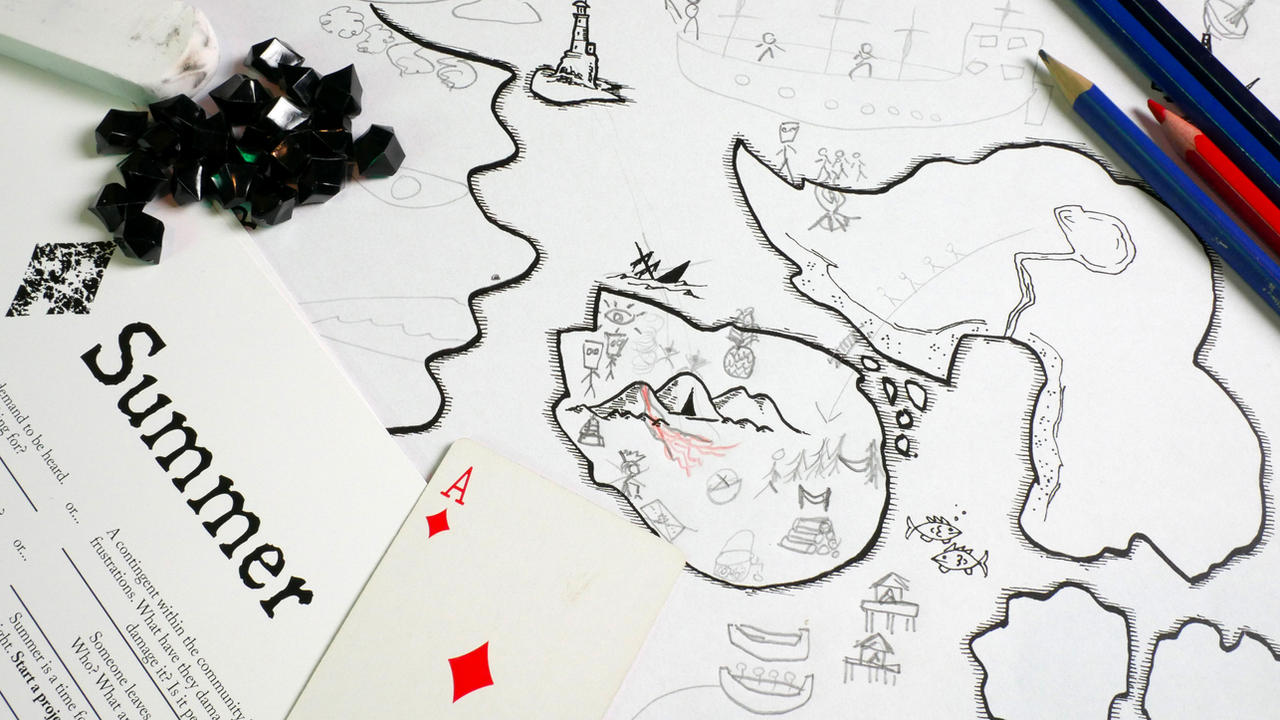As I hold a small brown booklet out in front of me, I can feel my voice change as I begin to read. I am the narrator, the facilitator, the appointed herald that will bring forth whatever creative endeavor was about to begin. Four expectant players sat around me, gazing at the empty sheet of paper in front of them. At the moment, it held no meaning, but in just an hour it would turn into so much more. In all my years as a game-master, I had never observed a game so strikingly simple in its design, yet complex in its execution, as The Quiet Year. However, I am getting ahead of myself. To fully realize how The Quiet Year shapes its player experience, we must return to the beginning.
“For a long time, we were at war with The Jackals. But now, we’ve driven them off, and we have this – a year of relative peace…”
The Quiet Year is a TTRPG developed by Avery Alder, a game designer focused on the narratives that can be found within TTRPGs. Her philosophy centers around what we can ascertain from the stories we create, and in all of her projects, she aims to foster a sense of community and connectedness. Within the game, players must lightly shape a landscape and decide which resources to classify as scarce and which to make abundant. Once the stage is set, players rotate, pulling a development card, each of which represents a week of time, and shaping the story and map according to their interpretation. The game continues until The Frost Shepherds arrive, upon which the game ends.
A good TTRPG should be built upon the pillars of narrative architecture, which includes narrative components and interactive moments that help funnel the player throughout the overarching game. Narrative is the framework through which the players must operate, and interactivity is how they choose to address their situation within the realm of narrative architecture. Within The Quiet Year, however, the role of being a narrative architect is granted to every player, and as you cycle through the events of the game, individuals are allowed to act as they see fit given the various situations.
The game-master holds a unique position within the game. They do not directly influence the game or course correct any actions, rather, they serve as the narrator who reads the rules aloud, and then proceeds to carefully assist the players with navigating the game. Otherwise, their role is moreso one of observation, and while this may seem off putting for a player, I actually found it incredibly rewarding.
Usually the GM’s role within a game is to craft the narrative for players to interact with, but in The Quiet Year, my role was to prepare the players and immerse them within the context of the world. This singular degree of separation, through which I prepared the game and explained the mechanics, was incredibly important to establishing an experience that made the players feel as if they were constantly in character. The players didn’t feel as if they were facilitating the game, rather the game was crafted and prepared for them. They didn’t reference the rule book, they referenced me, which allowed me to then deliver a more personal and explanatory answer. Sure, I am fairly confident that I messed up the rules along the way, but the fluidness of my answer was based around what I felt would give the players a more enjoyable experience.
From my outward perspective, I got to see how everyone’s actions interrelated with the changing landscape. When presented with possible choices as to what event took place that week, players never chose to directly interfere with one another, rather, they would insert their own creative solution. All of the decisions were facilitated by cards that would offer a choice for each player. In some cases, to promote action, individuals would decide the radical choice was best, but it never caused conflict within the group. Rather, this was the new problem to be solved, and the group had to work as a whole to overcome the situations. No event ever felt too alienating or monumental, they simply continued the course of the story.
For myself, the beauty of The Quiet Year is found in the interactions between players, and how the game is crafted to shape narrative experiences without the major story beats being focused on one individual. The format of the events ensured that no individual player ever felt like their decision was harming other players, instead it was seen as a challenge to overcome. It fostered a sense of community by ensuring participants approached solutions in a way that was best for the entire community.
With that, I would like to take a moment of silence for The Quiet Year, a game who’s structure has genuinely changed my perspective on the GM’s role within a game, and shown me how some carefully placed narrative, blank pieces of paper, and a world of creativity can masterfully craft a memorable experience.
